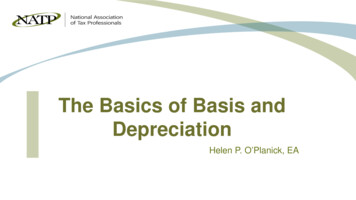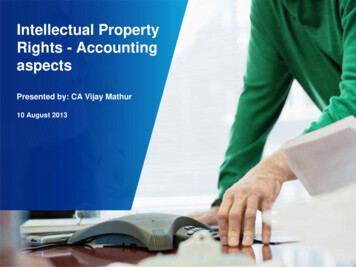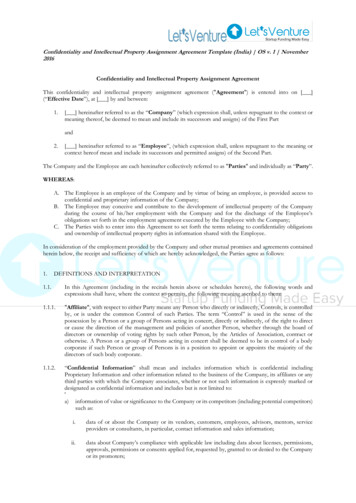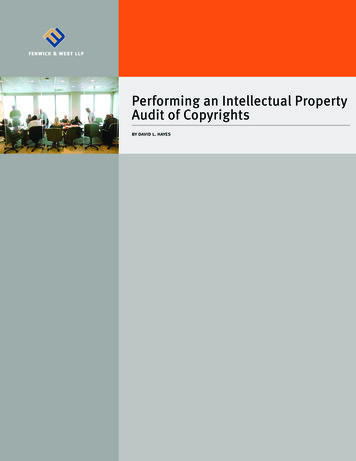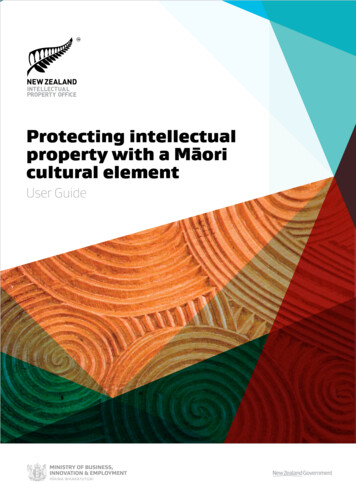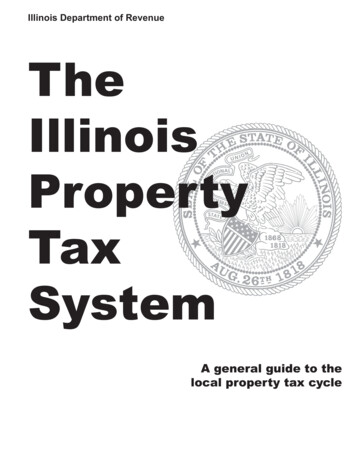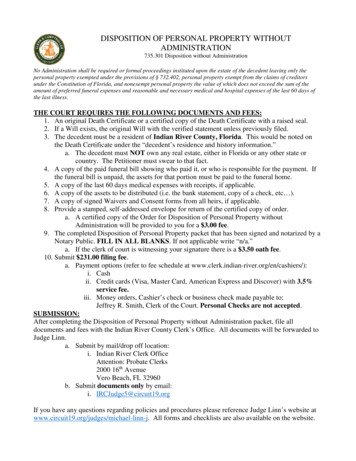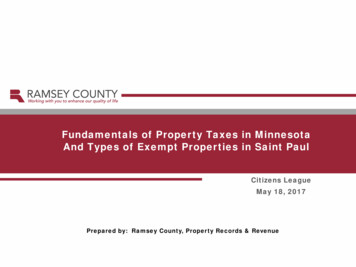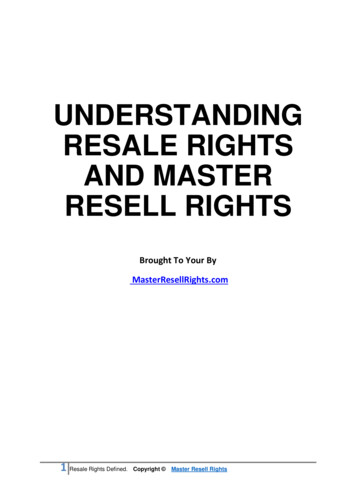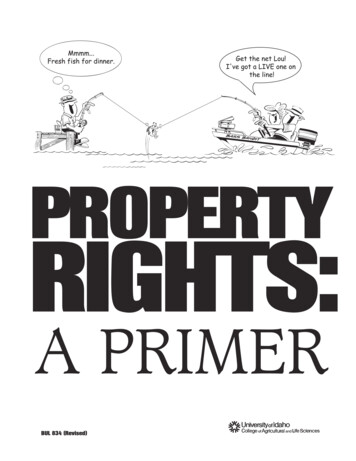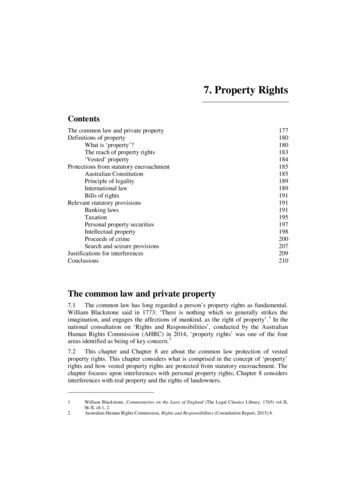
Transcription
7. Property RightsContentsThe common law and private propertyDefinitions of propertyWhat is ‘property’?The reach of property rights‘Vested’ propertyProtections from statutory encroachmentAustralian ConstitutionPrinciple of legalityInternational lawBills of rightsRelevant statutory provisionsBanking lawsTaxationPersonal property securitiesIntellectual propertyProceeds of crimeSearch and seizure provisionsJustifications for 9191191191195197198200207209210The common law and private property7.1 The common law has long regarded a person’s property rights as fundamental.William Blackstone said in 1773: ‘There is nothing which so generally strikes theimagination, and engages the affections of mankind, as the right of property’. 1 In thenational consultation on ‘Rights and Responsibilities’, conducted by the AustralianHuman Rights Commission (AHRC) in 2014, ‘property rights’ was one of the fourareas identified as being of key concern. 27.2 This chapter and Chapter 8 are about the common law protection of vestedproperty rights. This chapter considers what is comprised in the concept of ‘property’rights and how vested property rights are protected from statutory encroachment. Thechapter focuses upon interferences with personal property rights; Chapter 8 considersinterferences with real property and the rights of landowners.12William Blackstone, Commentaries on the Laws of England (The Legal Classics Library, 1765) vol II,bk II, ch 1, 2.Australian Human Rights Commission, Rights and Responsibilities (Consultation Report, 2015) 8.
178 Traditional Rights and Freedoms—Encroachments by Commonwealth Laws7.3 Almost a century before Blackstone wrote, conceptualisations of property werebound up in the struggle between parliamentary supremacy and the power of themonarch. This conflict resulted in the ‘Glorious Revolution’ of 1688, in which theRoman Catholic king, James II, was overthrown in favour of his Protestant daughter,Mary, and her husband, William of Orange, Stadtholder of the Netherlands, as Mary IIand William III. John Locke (1632–1704) celebrated property as a ‘natural’ right,advocating the protection of a citizen in ‘his Life, Health, Liberty, or Possessions’. 3Jeremy Bentham (1748–1832) continued the philosophical argument about property,anchoring it in laws:Property and law are born together, and die together. Before laws were made therewas no property; take away laws, and property ceases.47.4 By the period following World War II, the protection of private property rightsfrom interference had become enshrined in the first international expression of humanrights, the Universal Declaration of Human Rights (UNDHR) in 1948,5 in providingthat ‘[n]o one shall be arbitrarily deprived of his property’.67.5 Property and possessory rights are explicitly protected by the law of torts and bycriminal laws and are given further protection by rebuttable presumptions in thecommon law as to statutory interpretation, under the principle of legality, discussedbelow. An interference with real property in the possession of another may give rise tothe tort of trespass to land or of nuisance. 7 In the leading case of Entick v Carrington,Lord Camden LCJ said:By the laws of England, every invasion of private property, be it ever so minute, is atrespass. No man can set his foot upon my ground without my licence, but he is liableto an action, though the damage be nothing . If he admits the fact, he is bound toshew by way of justification, that some positive law has empowered or excused him.87.6 Similarly, the common law provides protection against unauthorisedinterference or detention of chattels. Entick v Carrington concerned not just anunauthorised search but also a seizure of private papers. Wilkes v Wood9 set outenduring common law principles against unauthorised search and seizure, laterreflected in the fourth amendment to the United States Constitution.3456789John Locke, Two Treatises of Government (Cambridge University Press, First Published 1690, 2nd Ed,Peter Laslett Ed, 1967) 289. The timing of the publication relevant to the negotiation of the ascension ofWilliam and Mary is explained by Peter Laslett, in ch III of his introduction to the Two Treatises.Jeremy Bentham, ‘Principles of the Civil Code’ in The Works of Jeremy Bentham, Published under theSupervision of His Executor John Bowring (1843) vol 1 pt I ch VIII ‘Of Property’, 309a. One of the main17th century arguments about property was whether it was founded in ‘natural’ or ‘positive’ law.Bentham is representative of the positivist approach that was the foundation of modern thinking aboutproperty.Universal Declaration of Human Rights, GA Res 217A (III), UN GAOR, 3rd Sess, 183rd Plen Mtg, UNDoc A/810 (10 December 1948).Ibid art 17(2).See Ch 8.Entick v Carrington (1765) 19 St Tr 1029. The version of the report included in the English Reports, 95ER 807, is an abbreviated form and does not include this precise quote.Wilkes v Wood [1763] 2 Wilson 203; 98 ER 489.
7. Property Rights1797.7 Unauthorised interferences with chattels may be a trespass or conversion of thechattels, while unauthorised detention, even if initially authorised by statute, may giverise to tort actions in conversion or detinue once that authority has lapsed. For example,in National Crime Authority v Flack, the plaintiff, Mrs Flack, successfully sued theNational Crime Authority and the Commonwealth for the return of money found in herhouse and seized by the Authority. Heerey J noted a common law restriction on theseizure of property under warrant:[A]t common law an article seized under warrant cannot be kept for any longer than isreasonably necessary for police to complete their investigations or preserve it forevidence. As Lord Denning MR said in Ghani v Jones [1970] 1 QB 693 at 709: ‘Assoon as the case is over, or it is decided not to go on with it, the article should bereturned’.107.8 Within the modern parliamentary context, many laws have been made thatinterfere with property rights. The focus then is upon how far such interference can go,before it may be regarded, for example, as an ‘arbitrary deprivation’, in the language ofthe UDHR. In his Commentaries on the Laws of England, while calling the right toproperty an absolute right 11 anchored in the Magna Carta, Blackstone described thelimited power of the legislature to encroach upon it in terms that are still reflected inlaws today:The third absolute right, inherent in every Englishman, is that of property: whichconsists in the free use, enjoyment, and disposal of all his acquisitions, without anycontrol or diminution, save only by the laws of the land . The laws of England are .extremely watchful in ascertaining and protecting this right. Upon this principle thegreat charter has declared that no freeman shall be disseised, or divested, of hisfreehold, or of his liberties, or free customs, but by the judgment of his peers, or bythe law of the land.127.9Property rights could be encroached upon ‘by the law of the land’, but onlywhere reasonable compensation was given:But how does [the legislature] interpose and compel? Not by absolutely stripping thesubject of his property in an arbitrary manner; but by giving him a fullindemnification and equivalent for the injury thereby sustained . All that thelegislature does is to oblige the owner to alienate his possessions for a reasonableprice; and even this is an exertion of power, which the legislature indulges withcaution, and which nothing but the legislature can perform.1310111213National Crime Authority v Flack (1998) 86 FCR 16, 27. Heerey J continued: ‘Section 3ZV of the CrimesAct . introduced by the Crimes (Search Warrants and Powers of Arrest) Amendment Act 1994 (Cth) .did not come into force until after the issue and execution of the warrant in the present case. However itwould appear to be not relevantly different from the common law’. For the current law, see Crimes Act1914 (Cth) ss 3ZQX–3ZQZB.Blackstone named two other absolute rights: the right of personal security and the right of personalliberty.Blackstone, above n 1, vol I, bk I, ch 1, 134.Ibid vol I, bk I, ch 1, 135. This passage is cited in, eg, R & R Fazzolari Ltd v Parramatta City Council(2009) 237 CLR 603, [41] (French CJ).
180 Traditional Rights and Freedoms—Encroachments by Commonwealth Laws7.10 As French CJ affirmed in R & R Fazzolari Ltd v Parramatta City Council, it‘was and has remained the case in England and Australia that compulsory acquisitionand compensation for such acquisition is entirely the creation of statute’. 14Definitions of propertyWhat is ‘property’?7.11 The idea of property is multi-faceted. The term ‘property’ is used in commonand some legal parlance to describe types of property that is both real and personal.‘Real’ property encompasses interests in land and fixtures or structures upon the land.‘Personal’ property encompasses tangible or ‘corporeal’ things—chattels or goods. Italso includes certain intangible or ‘incorporeal’ legal rights, also known in law as‘choses in action’, such as copyright and other intellectual property rights, shares in acorporation, beneficial rights in trust property, rights in superannuation 15 and somecontractual rights, including, for example, many debts. 16 Intangible rights are createdby law. Tangible things exist independently of law but law governs rights of ownershipand possession in them—including whether they can be ‘owned’ at all.177.12 In law, the term ‘property’ is perhaps more accurately or commonly used todescribe types of rights—and rights in relation to things. In Yanner v Eaton, the HighCourt of Australia said:The word ‘property’ is often used to refer to something that belongs to another. But .‘property’ does not refer to a thing; it is a description of a legal relationship with athing. It refers to a degree of power that is recognised in law as power permissiblyexercised over the thing. The concept of ‘property’ may be elusive. Usually it istreated as a ‘bundle of rights’.187.13 The ‘bundle of rights’ that property involves, acknowledges that rights in thingscan be split: for example, between rights recognised at common law (‘legal’ interests)and those recognised in equity (‘equitable’ or ‘beneficial’ interests); and between an1415161718R & R Fazzolari Ltd v Parramatta City Council (2009) 237 CLR 603, [41]. French CJ cited the followingauthorities: Rugby Joint Water Board v Shaw-Fox 1973 AC 202, 214 (Lord Pearson); WalkerCorporation Pty Ltd v Sydney Harbour Foreshore Authority (2008) 233 CLR 259, [29].Greville v Williams (1906) 4 CLR 694.City of Swan v Lehman Bros Australia Ltd (2009) 179 FCR 243.In Yanner v Eaton, the High Court cited the common law example of wild animals, or ferae naturae: ‘Atcommon law, wild animals were the subject of only the most limited property rights. . An action fortrespass or conversion would lie against a person taking wild animals that had been tamed, or a persontaking young wild animals born on the land and not yet old enough to fly or run away, and a land ownerhad the exclusive right to hunt, take and kill wild animals on his own land. Otherwise no person hadproperty in a wild animal’: Yanner v Eaton (1999) 201 CLR 351, 366 (Gleeson CJ, Gaudron, Kirby andHayne JJ); 80–81 (Gummow J). See also Blackstone, above n 1, vol II, bk II, ch 1, 14.Yanner v Eaton (1999) 201 CLR 351, 365–6 (Gleeson CJ, Gaudron, Kirby and Hayne JJ). ‘Property, inrelation to land, is a bundle of rights exercisable with respect to the land. The tenant of an unencumberedestate in fee simple in possession has the largest possible bundle’: Minister of State for the Army v Dalziel(1944) 68 CLR 261, 284 (Rich J). O’Connor traces the theoretical development of the ‘bundle of rights’approach: Pamela O’Connor, ‘The Changing Paradigm of Property and the Framing of Regulation as aTaking’ (2011) 36 Monash University Law Review 50, 54–6.
7. Property Rights181owner as lessor and a tenant as lessee. Equitable interests may further be subdivided toinclude ‘mere equities’.197.14 In Yanner v Eaton, Gummow J summarised this complexity:Property is used in the law in various senses to describe a range of legal and equitableestates and interests, corporeal and incorporeal. Distinct corporeal and incorporealproperty rights in relation to the one object may exist concurrently and be held bydifferent parties. Ownership may be divorced from possession. At common law,wrongful possession of land might give rise to an estate in fee simple with the rightfulowner having but a right of re-entry. Property need not necessarily be susceptible oftransfer. A common law debt, albeit not assignable, was nonetheless property. Equitybrings particular sophistications to the subject. The degree of protection afforded byequity to confidential information makes it appropriate to describe it as having aproprietary character, but that is not because property is the basis upon whichprotection is given; rather this is because of the effect of that protection. Hohfeldidentified the term ‘property’ as a striking example of the inherent ambiguity andlooseness in legal terminology. The risk of confusion is increased when, withoutfurther definition, statutory or constitutional rights and liabilities are so expressed asto turn upon the existence of ‘property’. The content of the term then becomes aquestion of statutory or constitutional interpretation.207.15 As Gummow J suggests in this passage, ‘possession’ is a distinct and complexconcept. Its most obvious sense is a physical holding (of tangible things), or occupation(of land). An example is when goods are in the custody of another, where things arepossessed on account of another. 217.16 A ‘property right’ may take different forms depending on the type of property.Implicit in a property right, generally, are all or some of the following rights: the rightto use or enjoy the property, the right to exclude others, and the right to sell or giveaway.22 Property rights also depend on the statutory framework of laws and propertyrights affecting the particular type of property, for example, the system of land tenurein a particular state or territory, or a scheme such as the Personal Property SecuritiesAct 2009 (Cth), and the interaction between that statutory scheme and the common law.7.17 For land and goods, both of which may be possessed by someone other than thelawful owner, property rights in the sense of ownership must be distinguished frommere possession of the land or goods, even though the latter may give rise to qualifiedlegal rights,23 and from mere contractual rights affecting the property. The particular1920212223See, eg, the discussion of the ‘enforceability of equities’ in Brendan Edgeworth et al, Sackville & NeaveAustralian Property Law (LexisNexis Butterworths, 9th ed, 2013) 401–16.Yanner v Eaton (1999) 201 CLR 351, 388–9. Gummow J refers to Wesley Hohfeld, ‘Some FundamentalLegal Conceptions as Applied in Judicial Reasoning’ (1913) 23 Yale Law Journal 16.See, eg, Edgeworth et al, above n 19, 94–110.Milirrpum v Nabalco (1971) 17 FLR 141, 171 (Blackburn J). See discussion in Edgeworth et al, aboven 19. See also: Kevin Gray, ‘Property in Thin Air’ (1991) 50 Cambridge Law Journal 252. Someproperty rights may however be unassignable: see, Edgeworth et al, above n 19, 6.Actual possession may give the possessor better rights than others whose interest does not derive from thetrue owner: see Newington v Windeyer (1985) 3 NSWLR 555 (land) or National Crime Authority v Flack(1998) 86 FCR 16 (goods). See also the quote of Gummow J in Yanner v Eaton, above. Possession may,in effect, give the possessor rights akin to proprietary rights. Note, ‘Not only is a right to possession a
182 Traditional Rights and Freedoms—Encroachments by Commonwealth Lawsright may be regarded as ‘proprietary’ even though it is subject to certain rights ofothers in respect of the same property: a tenancy of land, for example, gives the tenantrights that are proprietary in nature as well as possessory.7.18 The ‘bundle of rights’ approach has presented some contemporary challenges,particularly in relation to land holding. Laws that limit what a landowner can do, forexample by creating rights in others in the same land, may give rise to arguments aboutcompensability, expressed in the question, when does regulating what someone may dowith land become a ‘taking’ of that land? This is considered later and in Chapter 8.7.19 What may amount to a property right is of ongoing philosophical and practicalinterest. One clear historical example is the recognition of copyright from the 17thcentury, as a new form of intangible personal property created by statute and thedevelopment of a specialist body of law governing its creation and transfer. Trademarks and registered designs have a similar genesis, as statutory creations. 247.20 The recognition of new forms of intangible property may be argued in thecontext of s 51(xxxi) of the Constitution, which is considered below. Argumentsconcerning rights over one’s person, for example claims over bodies and body parts,including reproductive material, are lively. 25 The need to recognise ‘traditionalknowledge and traditional cultural expressions of Aboriginal and Torres Strait Islanderpeople’ has also been advanced. In this Inquiry, the Arts Law Centre argued forrecognition of cultural knowledge as intellectual property and subject to appropriateprotection, noting that the Native Title Act 1993 (Cth) did not do so. 26 Similarintellectual property issues were raised in the Rights and Responsibilitiesconsultation. 277.21 The significance of recognising cultural knowledge was identified by the ALRCin the report, Connection to Country: Review of the Native Title Act 1993 (Cth). Whilethis issue lay outside the Terms of Reference for that Inquiry, the ALRC concluded thatthe question of how cultural knowledge may be protected and any potential rights toits exercise and economic utilisation governed by the Australian legal system wouldbe best addressed by a separate review. An independent inquiry could bring to fruitionthe wide-ranging and valuable work that has already been undertaken but which still24252627right of property but where the object of proprietary rights is a tangible thing it is the most characteristicand essential of those rights’: Minister of State for the Army v Dalziel (1944) 68 CLR 261, 284 (Rich J).Patent rights were held to be property rights that attracted the presumption against divesting by legislationor delegated regulations: UWA v Gray [2008] FCA 498 [89].See, eg, Margaret Davies and Ngaire Naffine, Are Persons Property? (Ashgate, 2001); RosalindCroucher, ‘Disposing of the Dead: Objectivity, Subjectivity and Identity’ in Ian Freckelton and KerryPeterson (eds), Disputes and Dilemmas in Health Law (Federation Press, 2006) 324; Donna Dickenson,Property in the Body: Feminist Perspectives (Cambridge University Press, 2007); Rohan Hardcastle, Lawand the Human Body: Property Rights, Ownership and Control (Hart Publishing, 2007); MuireannQuigley, ‘Property in Human Biomaterials—Separating Persons and Things’ (2012) 32 Oxford Journal ofLegal Studies 659; Muireann Quigley, ‘Propertisation and Commercialisation: On Controlling the Uses ofHuman Biomaterials’ (2014) 77 Modern Law Review 677. The issue was tested, for example, in Roblin vPublic Trustee for the Australian Capital Territory [2015] ACTSC 100. The case concerned whethercryogenically stored semen constitutes property which, upon the death of the person, constitutes propertyin his estate.Arts Law Centre of Australia, Submission 50.Australian Human Rights Commission, Rights and Responsibilities (Consultation Report, 2015) 44–5.
7. Property Rights183incompletely addresses the protection of Aboriginal and Torres Strait Islanderpeoples’ cultural knowledge.287.22 Understandings about what amounts to property reveal a certain fluidity whenviewed historically. As one stakeholder commented:The rights that attach to different objects, be they land, personal or intellectualproperty are not frozen in time. Just as for all legal rights, the nature and content ofproperty rights will evolve and potentially change quite significantly over time.297.23 Similarly, with respect to land, Professor Peter Butt noted that the ‘categories ofinterests in land are not closed’ and they ‘change and develop as society changes anddevelops’. 307.24 Another challenge in terms of property rights in the Australian context is therecognition of native title; and understanding how such interests in land or waters fitwithin, or relate to, the understanding of property rights of the common law. 31The reach of property rights7.25 Complex interactions of property rights of different forms fill chapters of bookson property law under the generic heading of ‘priorities’, where rules of law andequity, including statute law, have, over the centuries, established what propertyinterest takes priority over another in given circumstances, regulating competingproperty interests. Each circumstance may involve a ‘loser’ in the sense of someonelosing out in a contest of proprietary rights (rights in rem), and being relegated in suchcircumstances to whatever rights may be pursued against the individuals concerned(rights in personam). Some examples, expressed in very general terms, suffice toillustrate:·the priority of the bona fide purchaser of a legal estate for value without noticeof a prior equitable interest; 32·the indefeasibility of registered interests under Torrens title land systems; 3328Australian Law Reform Commission, Connection to Country: Review of the Native Title Act 1993 (Cth),Report No 126 (2015) [8.176]–[8.177]. The ALRC noted extensive work on the topic: eg, IP Australia,Australia’s Indigenous Knowledge Consultation www.ipaustralia.gov.au ; World Intellectual PropertyOrganization, Protection of Traditional Cultural Expressions and Traditional Knowledge–Gap Analyses http://www.wipo.int/tk/en/igc/gap-analyses.html .Environmental Justice Australia, Submission 65.Peter Butt, ‘Carbon Sequestration Rights—A New Interest in Land?’ (1999) 73 Australian Law Journal235. The particular example Butt cited was of ‘the slow emergence of an interest not previously known tothe law, the “carbon sequestration right”’, which has been given statutory force: in New South Waleswithin the well-known common law interest in land, the profit à prendre; in Victoria within a specificlegislative framework, the Forestry Rights Act 1996 (Vic).See Australian Law Reform Commission, Connection to Country: Review of the Native Title Act 1993(Cth), Report No 126 (2015) Chs 4 and 6.See, eg, Edgeworth et al, above n 19, ch 4.See, eg, Ibid ch 5.2930313233
184 Traditional Rights and Freedoms—Encroachments by Commonwealth Laws·the effect of registration on priority of registered security interests in personalproperty;34 and·the doctrine of fixtures, in which items of personal property—chattels—maylose their quality as personal property and become part of the land. 357.26 A further illustration of property rights being lost may come through theoperation of statutory limitation over time. So, for example, a person may be held toacquire title to land by long ‘adverse’ possession. The adage, ‘possession is nine-tenthsof the law’, is reflected in the modern expression of title by possession in theLimitation of Actions legislation.36 Under such legislation, the claim of a person maybe barred after a designated period, generally between 12 and 15 years. 37 There isauthority that even under Torrens title systems, title may be gained by adversepossession.387.27 A further question about the extent of property rights includes how far the titleof a landowner extends in the air above and the earth below. Cases involvingscaffolding, overflying and cranes, have tested airspace rights. 39 Cases involvingsubterranean caves, treasures and minerals have tested the limits below the surface. 40An aspect of such issues concerns prerogative claims to minerals, including substanceslike coal.417.28 The extent of property rights can be at issue when it is argued that rights ofproperty have been taken away and therefore that the property owner is entitled tocompensation for that ‘taking’. This was raised by stakeholders in this Inquiry in thecontext of environmental regulation issues, water rights and intellectual property.‘Vested’ property7.29 The ALRC’s Terms of Reference refer to ‘vested property rights’. ‘Vested’ isprimarily a technical legal term in property law used to differentiate a presentlyexisting interest from a contingent interest. 42 However, particularly in the United343536373839404142Under the Personal Property Securities Act 2009 (Cth). The system is explained on the website of theAustralian Financial Security Authority, which administers the legislation: https://www.afsa.gov.au/.See, eg, Edgeworth et al, above n 19, [1.79].See, eg, Ibid 139–72. In Yanner v Eaton, Gummow J noted that ‘[o]wnership may be divorced frompossession’, giving the example that, ‘[a]t common law, wrongful possession of land might give rise to anestate in fee simple with the rightful owner having but a right of re-entry’: Yanner v Eaton (1999) 201CLR 351, 388.See, eg, Edgeworth et al, above n 19, 144–5.See, eg, Ibid 517–20.See, eg, Ibid 66–7.See eg, Bulli Coal Mining Co v Osborne [1899] AC 351; Edwards v Sims (1929) 24 SW 2D 619; Elwes vBrigg Gas Co (1883) Ch D 33 562. See also Adrian J Bradbrook, ‘Relevance of the Cujus Est SolumDoctrine to the Surface Landowner’s Claims to Natural Resources Located Above and Beneath the Land’(1987) 11 Adelaide Law Review 462.See Ch 8.That is, contingent on any other person’s exercising his or her rights: ‘an immediate right of present orfuture enjoyment’: Glenn v Federal Commissioner of Land Tax (1915) 20 CLR 490, 496, 501. See alsoPlanning Commission (WA) v Temwood Holdings Pty Ltd (2004) 221 CLR 30. The term ‘vested’ hasbeen used to refer to personal property, including a presently existing and complete cause of action: seeGeorgiadis v AOTC (1994) 179 CLR 297.
7. Property Rights185States, the term has acquired rhetorical force in reinforcing the right of the owner not tobe deprived of the property arbitrarily or unjustly by the state43 or, in disputes over landuse, to reflect the confrontation between the public interest in regulating land use andthe private interest of the owner—including a developer—in making such lawful use ofthe land as he or she desires. 44 The tension is particularly strong with respect toretrospective legislation.457.30 In this Inquiry the ALRC considers ‘vested property rights’ more in its broad,rhetorical sense, than in its technical sense, in which there are distinct shades ofmeaning of ‘vested’. 46Protections from statutory encroachment7.31 Property rights find protection in the Australian Constitution, through theprinciple of legality at common law, and, to some extent, in international law.Australian Constitution7.32 The Constitution protects property from one type of interference: acquisitions bythe Commonwealth other than ‘on just terms’. Section 51(xxxi) of the Constitutionprovides that the Commonwealth Parliament may make laws with respect to:the acquisition of property on just terms from any State or person for any purpose inrespect of which the Parliament has power to make laws.7.33 There is no broader constitutional prohibition on the making of laws thatinterfere with vested property rights. The language of s 51(xxxi) was adapted from thefifth amendment to the United States Constitution. However, the American provision is‘formulated as a limitation on power’, while the Australian provision is ‘expressed as agrant of power’ 47—to acquire property. Nevertheless, this constitutional protection issignificant and is regarded as a constitutional guarantee of property rights. 48Barwick CJ described s 51(xxxi) as ‘a very great constitutional safeguard’. 49 Becauseof the potential of invalidity of legislation that may offend s 51(xxxi), express43444546474849American States Water Service Co v Johnson 31 Cal App 2d 606, 614; 88 P2d 770, 774 (1939).Walter Witt, ‘Vested Rights in Land Uses—A View from the Practitioner’s Perspective’ (1986) 21 RealProperty, Probate and Trust Journal 317. A right is described as immutable and therefore ‘vested’ whenthe owner has made ‘substantial expenditures or commitments in good faith reliance on a validly issuedpermit’: Terry Morgan, ‘Vested Rights Legislation’ (2002) 34 Urban Lawyer 131.‘There is no remedial act which does not affect some vested right, but, when contemplated in its totaleffect, justice may be overwhelmingly on the other side’: George Hudson Limited v Australian TimberWorkers’ Union (1923) 32 CLR 413, 434 (Isaacs J).For example: ‘vested in interest’, ‘vested in possession’. See, eg, Peter Butt, Land Law (Lawbook Co, 5thed, 2006) [612].Anthony Blackshield and George Williams, Australian Constitutional Law and Theory (Federation Press,4th ed, 2006) 1274.Bank of NSW v Commonwealth (Bank Nationalisation Case) (1948) 76 CLR 1, 349. Dixon J. Theprovision reflects the ideal enunciated by Blackstone in the 1700s that, where the legislature deprives aperson of their property, fair payment should be made: it is to be treated like a purchase of the property atthe market value. This provision does not apply to acquisitions by a state: Durham Holdings Pty Ltd vNew South Wales (2001) 205 CLR 399. See Ch 8.Trade Practices Commission v Tooth & Co Ltd (1979) 142 CLR 397, 403.
186 Traditional Rights and Freedoms—Encroachments by Commonwealth Lawsprovisions for compensation have been included. In addition to a general statute—theLands Acquisition Act 1989 (Cth)—a number of specific compensatory provisions havebeen included in many statutes. 50 There are also ‘fail safe’ provisions, 51 collectivelydescribed as ‘historic shipwrec
great charter has declared that no freeman shall be disseised, or divested, of his freehold, or of his liberties, or free customs, but by the judgment of his peers, or by . treated as a 'bundle of rights'.18 7.13 The 'bundle of rights' that property involves, acknowledges that rights in things can be split: for example, between rights .
